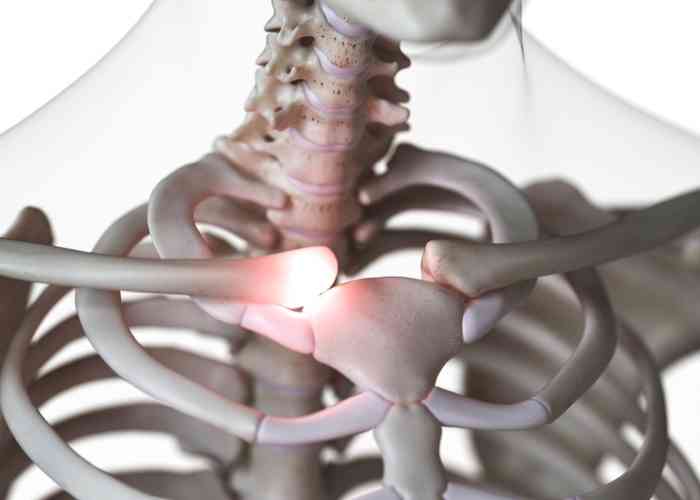What is a sternoclavicular joint injury?
The clavicle (collarbone) and sternum (breastbone) join together to form the sternoclavicular (SC) joint, one of the joints within the shoulder. Similar to a saddle joint, the SC joint allows for movement in several directions but is inherently stable. The SC joint, like the other shoulder joints, can experience a joint separation when the connecting ligaments are pulled away from their attachment sites. A sternoclavicular joint separation is the result of the clavicle being pulled away from the sternum. This type of injury is incredibly rare as the ligaments connecting the SC joint are able to absorb and disseminate external forces away from the joint and into the sternum. Athletes have a greater likelihood of experiencing an SC joint injury, particularly those involved in aggressive contact sports such as football and wrestling. However, non-athletic individuals can still experience an SC joint injury from a motor vehicle collision or degenerative changes with the natural aging process. Dr. Ronak Mukesh Patel, orthopedic shoulder specialist serving patients in Sugar Land, Pearland, and the Houston, Texas area, has the knowledge and understanding, as well as substantial experience, in treating patients who have experienced a sternoclavicular joint injury.

How are sternoclavicular joint injuries classified?
The sternoclavicular (SC) joint can separate in two different ways. An anterior joint separation occurs when the end of the clavicle is pushed forward in front of the sternum. A posterior separation occurs when the end of the clavicle is pushed backward and behind the sternum. These SC joint injuries are graded by the severity of the damage and placed into three different categories.
- Grade 1: The ligaments may be stretched or partially torn resulting in a slight displacement of the SC joint.
- Grade 2: The ligaments between the sternum and clavicle of the SC joint may become partially or completely torn from their attachment site.
- Grade 3: All of the SC joint ligaments are damaged in this type of injury. If moderate to severe damage was sustained, the SC joint may be completely separated.
What are the symptoms of a sternoclavicular joint injury?
Pain surrounding the clavicle immediately following an injury is commonly reported with sternoclavicular joint injuries. Some other common symptoms of a sternoclavicular joint include:
- Arm pain that worsens with overhead lifting movements
- Pain across the clavicle or chest with lifting objects
- Clavicle instability
- Bruising and swelling of the sternoclavicular joint
- Difficulty breathing or swallowing
- An obvious visual deformity of the anterior chest
- A “popping” or “cracking” sensation
How is a sternoclavicular joint injury diagnosed?
A comprehensive medical history will be obtained by Dr. Patel and include the precipitating injury, any prior shoulder injuries, or other underlying health conditions. A thorough physical examination will follow to assess the injured shoulder’s range of motion and evaluate for areas of pain and tenderness. Diagnostic imaging studies, such as x-rays, computed tomography (CT) scan, and/or magnetic resonance imaging (MRI), can be useful in confirming the SC joint injury diagnosis as well as identifying any damage to the other structures of the sternoclavicular joint.
What is the treatment for a sternoclavicular joint injury?
Non-surgical treatment:
Sternoclavicular (SC) joint injuries typically respond well to non-surgical therapies. The shoulder joint is immobilized with a sling to facilitate proper healing and protect the damaged tissues from further injury. Pain and swelling are controlled with a combination of rest, ice, and non-steroidal anti-inflammatory medications (NSAIDs). When appropriate, a physical rehabilitation program may be recommended to restore strength and range of motion to the SC joint.
Occasionally, with more severe SC joint injuries, a reduction technique may be necessary to realign the joint. This reduction technique should only be performed by a professional experienced in the manual manipulation of the clavicle back to its correct anatomical position.
Surgical treatment:
Surgical intervention, however, may be necessary if non-surgical therapy fails to alleviate symptoms, or if there is significant damage to the bones and ligaments of the sternoclavicular (SC) joint. Dr. Patel typically performs a joint stabilization procedure that involves the repair or reconstruction of the damaged ligaments and secures the joint back in the correct anatomical position. Stabilizing and surgically reconstructing the SC joint allows for a full recovery and eliminates the risk of arthritis or dislocation.
SC Joint Injury Specialist

Are you an athlete that participates in aggressive contact sports like football, rugby, MMA or wrestling? If so, you may be at risk of injuring your sternoclavicular (SC) joint. The connective tissue of the SC joint in the shoulder can separate or pull away from their attachment sites, causing an SC joint separation. Sternoclavicular joint doctor, Ronak Mukesh Patel, provides diagnosis as well as surgical and nonsurgical treatment options for patients in Houston, Sugar Land, and Pearland, TX who have suffered an SC joint injury. Contact Dr. Patel’s team today!


